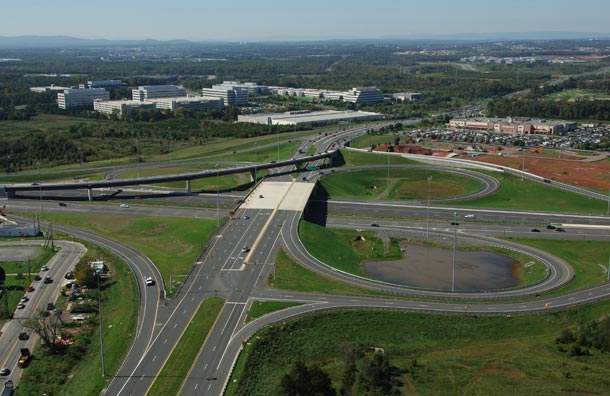 Last week we carried an Outer Beltway story using a cost estimate of 5 billion dollars. This is a number that was sourced for a bridge crossing and creating a complete outer beltway in the form of an ICC from Loudoun through Prince William County. Since that time we have done more investigating on the anticipated costs and have determined that much of the roadways in Virginia will already exist due to the Route 28 Limited Access project of the past decade. In reality only the expansion of Route 28 through Loudoun, with a few new interchanges, the bridge (and indirect elements), and the very lengthy portion of ICC addition within Maryland would be necessary. Maryland has continued to reiterate that State funds will NOT be used for this project and only a net zero project, one which is a private partnership funded through tolling, will be acceptable for connection across the Potomac.
Last week we carried an Outer Beltway story using a cost estimate of 5 billion dollars. This is a number that was sourced for a bridge crossing and creating a complete outer beltway in the form of an ICC from Loudoun through Prince William County. Since that time we have done more investigating on the anticipated costs and have determined that much of the roadways in Virginia will already exist due to the Route 28 Limited Access project of the past decade. In reality only the expansion of Route 28 through Loudoun, with a few new interchanges, the bridge (and indirect elements), and the very lengthy portion of ICC addition within Maryland would be necessary. Maryland has continued to reiterate that State funds will NOT be used for this project and only a net zero project, one which is a private partnership funded through tolling, will be acceptable for connection across the Potomac.
We continue to believe that environmental groups will oppose ANY 6-lane or greater bridge crossing of the Potomac in this very rural and bucolic region, but let’s carry out our calculations with the following costs. These values come from personal experience, costs via RS Means, as well as similar projects detailed within this post for bridging costs. Interchange costs were determined from a WaDOT study on the typical costs of diamond interchanges and from the Route 28 Limited Access project, adjusted for construction inflation.

Let’s assume a few things;
- Virginia will fund 300 million of this project.
- Let’s assume a private partnership of 50 years at an annual yield of 2% and all maintenance will be provided by the private entity at 0.5% annually, resulting in a total construction cost of $2.20 billion over the 50 years.
- Assume 40,000 crossings per day, based on current numbers (20,000 crossing anticipated) growing to 60,000 users in 50 years
- Let’s also assume that the toll road pricing will increase at 3% per year over the next 50 years, with an initial toll price of $2.00, and future cost of 9 dollars (ah the power of inflation of a half century), averaging to about 5 dollars per crossing for 50 years.
- Let’s continue to be super generous and say that even on the weekends these kinds of crossing numbers will continue.
The result from these dynamics would be a revenue of $3.65 billion dollars over the course of 50 years, 1.45 billion dollars over costs over that same period. This has a LOT of assumptions however that are very favorable. To counter balance this scenario lets look at a different dynamic as the low case scenario;
- Virginia will fund 300 million of this project in line with previous capital funds provided in Northern Virginia.
- Let’s assume a private partnership of 50 years at an annual yield of 4% (a reasonable rate for a toll road in an area with currently low usage) and all maintenance will be provided by the private entity at 0.5% annually, resulting in a total construction cost of $7.40 billion over the 50 years.
- Assume 40,000 crossings per day, based on current numbers (20,000 crossing anticipated) growing to 60,000 users in 50 years, we’ll keep it nice since with the above price tag Loudoun will actively pursue development in this region.
- Let’s also assume that the toll road pricing will increase at 3% per year over the next 50 years, with an initial toll price of $2.00, and future cost of 9 dollars (ah the power of inflation of a half century), averaging to about 5 dollars per crossing for 50 years.
- Let’s remove the idea that on the weekends rates will be maintained, and assume that over the course of a year the average daily use is really closer to 75% with weekend usage dropping significantly.
The result from these dynamics would be a revenue of $2.74 billion dollars over the course of 50 years, a 4.66 billion dollar failure over that same period. In reality the failure would be that of the private company that ends up with a poor return on this project. The reality is that either the toll rates would need to be much higher ($4 or $5 to start with) or a company would have to settle for a far smaller return on investment approximately 2.5% annually (not a lot of multi-billion dollar companies would be willing to fund at such a low return).
What does all of this mean? The future viability of this toll bridge is completely dependent on significant growth, maintaining both usership growth and toll rate growth in line with inflation rates (3%) in order to attract a private partner. In the absent of this private partner Virginia and Loudoun county must make up for the 600 million dollar shortfall, something that at a time of austerity and budget cuts is not fiscally wise. While this project is not an order of magnitude off from success, it simply is not the right time for THIS solution at THIS time. Clearly if this corridor would immediately generate 30,000 to 40,000 crossings it might be more viable, but for now it is an over-costly road through and to no where using funds which could be far better used removing vehicles closer in, and thereby improving traffic further out.


